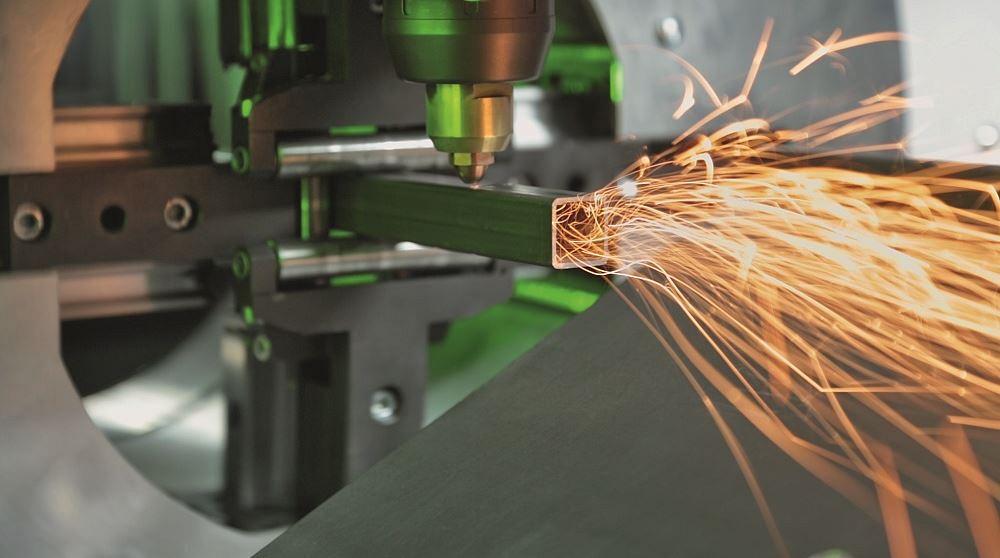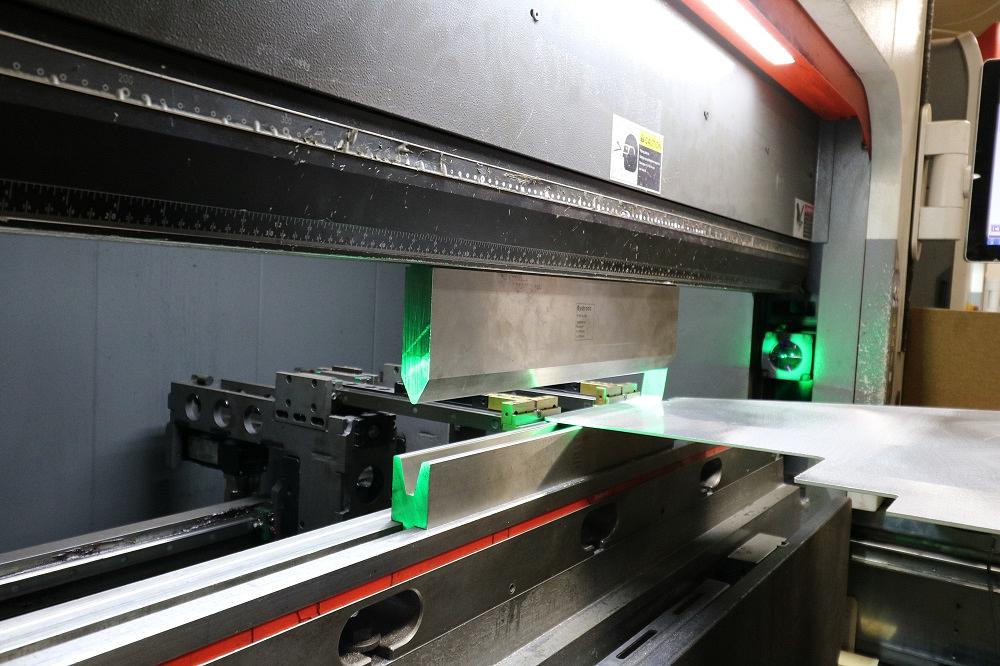Editor
- FMA
- The Fabricator
- FABTECH
- Canadian Metalworking
Categories
- Additive Manufacturing
- Aluminum Welding
- Arc Welding
- Assembly and Joining
- Automation and Robotics
- Bending and Forming
- Consumables
- Cutting and Weld Prep
- Electric Vehicles
- En Español
- Finishing
- Hydroforming
- Laser Cutting
- Laser Welding
- Machining
- Manufacturing Software
- Materials Handling
- Metals/Materials
- Oxyfuel Cutting
- Plasma Cutting
- Power Tools
- Punching and Other Holemaking
- Roll Forming
- Safety
- Sawing
- Shearing
- Shop Management
- Testing and Measuring
- Tube and Pipe Fabrication
- Tube and Pipe Production
- Waterjet Cutting
Industry Directory
Webcasts
Podcasts
FAB 40
Advertise
Subscribe
Account Login
Search
Metal fabricator looking at the future through laser-cut tube
Machinery and equipment investments open the door to new markets for manufacturer
- By Lincoln Brunner
- May 2, 2023
- Article
- Tube and Pipe Fabrication

Bystronic’s ByTube Star 130 fiber tube laser cuts with nitrogen, reducing or eliminating the need for secondary processes that often have to be done with other cutting methods.
Precision fabricator Unifab began life in 1940 as Kalamazoo Coaches. The company built a popular 16- to 18-passenger bus known as the Pony Cruiser, which could be found running passengers around communities as far flung from southwest Michigan as Oakland, Calif., and Winnipeg, Man.
Those buses, boasting all of 13 to 15 MPG, are a far cry from the emergency vehicles and RVs that the company builds chassis parts for nowadays. But in some ways, the tube laser just installed at Unifab’s shop on the Kalamazoo/Portage city line represents an even bigger departure from where the company stood technologywise just a few years ago.
When Unifab President Matt Hill came on board in 2015 in a sales leadership role under CEO Rob Thayer, the company hadn’t reinvested in its fabrication technology for some time, Hill said. That mindset changed immediately as Unifab’s leadership team began discussing new capital purchases.
The 4-kW ByTube Star 130 fiber laser that Unifab installed in February is the latest in a line of Bystronic machines that the company began purchasing in late 2018 to serve customers that need tubular and flat metal parts. Unifab’s equipment includes two flat fiber lasers (one automated and the second soon to be) and three press brakes ranging from 40 to 175 tons.
Unifab uses that and other equipment to provide many services, including flat sheet laser cutting, turret punching, press brake forming, welding, and powder coating. Because the company already had one laser in production, it wasn’t questioning the machine itself, but what customers it was going to go after once it had the capacity ready.
“About a year ago, we sat down and really looked at that five-year-type plan: Where do we want to be? Who do we want to be?” Hill said. “We have a revenue goal out there in five years, and we evaluated, ‘What it’s going to take to get to that point? What do we need to add? What’s our employee base look like?’ And the tube cutting service was a large player in that.”
Unifab’s new laser can process round tubes up to 5 in. OD in any material weighing up to 11 lbs./ft., which equates to wall thickness up to about 0.25 in. It has a 28-ft. infeed and 13-ft. outfeed, which gives operators a fair bit of leeway when processing long parts for its emergency vehicle and other customers. And using nitrogen as an assist gas eliminates the need for a lot of postprocessing that other methods might require, according to Bystronic Direct Sales Engineer Brian Jackson.
“They can cut these parts with nitrogen on their tube laser, and they don’t have to go through deburring or descaling afterward before going to weld,” Jackson noted.
In addition, the laser helps reduce processing times by decreasing the number of secondary fabrication steps that might be needed if Unifab were using other cutting methods, Jackson said.
“With the tube laser, they’re able to nest a tube as a connected frame that can be bent and held in place with limited clamping during the welding process,” Jackson said. “By doing this they’re able to reduce the processing time for each assembly and grow the downstream side of their business.”

In addition to laser cutting for flat and tubular parts, Unifab offers flat bending services on its three press brakes.
That, of course, is the idea. Unifab is hoping the laser will open the door to many new customers, especially in businesses like material handling and furniture that it has investigated and found potential in.
“Any large investment, whether it’s new technology or a new service, that’s a bit daunting,” Hill said. “You evaluate, ‘How much capacity do we need to fill this up with in order to break even?’ Really, overall, it’s the growth strategy that we looked at. We had some conversations with our customers about interest level, and that’s where we just made that decision to move forward.
“To me, this opens up new opportunities to a customer base that we don’t have right now,” he added. “We do business with some of these industries, but what it does is open that ability to do more with them—give them a single source. Some of these customers that may need tube in our mind may also need flat-cut forms and parts and welded assemblies that go with the tubes. So, if we’re able to get in with some of this tube business, in our minds, it will provide excellent service value to that customer. That then will open up opportunities on our other primary fabrication businesses.”
Unifab has reason for optimism. Over the past seven years, the company has grown its revenue by 600% and its workforce from about 10 to around 36, according to Hill. Those numbers speak to a continuing evolution, not just in its book of business, but in what it aspires to do for its customers.
“I’ve worked with a couple of our outside sales representatives, [and] they were putting a bug out there,” Hill said. “With our current customer base, I reached out and said, ‘What do you think? Do you have a need?’ We just tested that a little bit. In just a short period of time, we’ve already quoted business for customers that we have not quoted business for in the past. So, I think this is going to lead to some great opportunities for us as well as our customers.
“[With] what these pieces of equipment can do now, they can look at different designs and design changes to reduce welding and various things to essentially eliminate some cost. Now you can miter it in place, you can bend it in as a one-piece unit, and now you have eliminated some of that welding. I think there’s opportunity there.”
About the Author

Lincoln Brunner
2135 Point Blvd.
Elgin, IL 60123
(815)-227-8243
Lincoln Brunner is editor of The Tube & Pipe Journal. This is his second stint at TPJ, where he served as an editor for two years before helping launch thefabricator.com as FMA's first web content manager. After that very rewarding experience, he worked for 17 years as an international journalist and communications director in the nonprofit sector. He is a published author and has written extensively about all facets of the metal fabrication industry.
About the Publication
Related Companies
subscribe now

The Tube and Pipe Journal became the first magazine dedicated to serving the metal tube and pipe industry in 1990. Today, it remains the only North American publication devoted to this industry, and it has become the most trusted source of information for tube and pipe professionals.
start your free subscription- Stay connected from anywhere

Easily access valuable industry resources now with full access to the digital edition of The Fabricator.

Easily access valuable industry resources now with full access to the digital edition of The Welder.

Easily access valuable industry resources now with full access to the digital edition of The Tube and Pipe Journal.
- Podcasting
- Podcast:
- The Fabricator Podcast
- Published:
- 04/16/2024
- Running Time:
- 63:29
In this episode of The Fabricator Podcast, Caleb Chamberlain, co-founder and CEO of OSH Cut, discusses his company’s...
- Trending Articles
Team Industries names director of advanced technology and manufacturing

Orbital tube welding webinar to be held April 23

Chain hoist offers 60-ft. remote control range

Push-feeding saw station cuts nonferrous metals

Corrosion-inhibiting coating can be peeled off after use

- Industry Events
16th Annual Safety Conference
- April 30 - May 1, 2024
- Elgin,
Pipe and Tube Conference
- May 21 - 22, 2024
- Omaha, NE
World-Class Roll Forming Workshop
- June 5 - 6, 2024
- Louisville, KY
Advanced Laser Application Workshop
- June 25 - 27, 2024
- Novi, MI



























